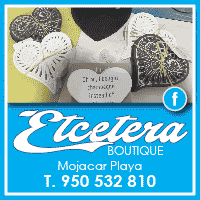Mojacar and Mojacar Playa guide
Mojacar village and beach resort, Mojacar Playa, Almeria, Andalucia, Spain.
Mojacar Pueblo, a whitewashed hilltop village with a picture book setting, nestles in the foothills of the 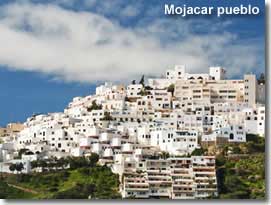 Sierra Cabrera mountain range overlooking the beach resort of Mojacar Playa where the Mediterranean sea washes onto a seventeen kilometre coastline of uncrowded sandy beaches.
Sierra Cabrera mountain range overlooking the beach resort of Mojacar Playa where the Mediterranean sea washes onto a seventeen kilometre coastline of uncrowded sandy beaches.
Choose Mojacar for holidays
Situated in the Levante area of the province, less than one hours drive from Almeria airport, Mojacar provides a central location for all the attractions of Almeria as well as a traditional holiday destination ideal for families and couples.
Quick links - Mojacar village and Mojacar Playa guide:
- Mojacar old town
- Village sightseeing tour
- Mojacar beach resort
- Property in Mojacar
- Fiestas
- Outdoor recreation
- Walking trails
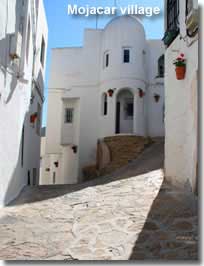
Mojacar Pueblo - the village
History, culture and heritage...
This enthralling hillside pueblo, with its jumble of narrow cobbled streets, both attracts and charms visitors all year round.
Populated since the Bronze Age, around 2000 BC, and subsequently by the Phoenicians, Carthaginians, Greeks and Romans, it was the North African Moors, who, after establishing themselves in Spain in the early 8th century, left their lasting mark on Mojacar long after the Christain conquest of the region at the end of the 15th century.
To this day the architecture remains true to its Moorish ancestors with many homes and buildings featuring this unmistakable Moroccan style.
From the 16th century, up to the end of the 18th century, the Christians spent much of their time defending the coastline against the North African pirates, though even after the disappearance of the buccaneers, life for the inhabitants of Mojacar still had many struggles in store.

In the 19th and 20th centuries the village saw periods plagued with war, drought and disease, although during the first of these centuries Mojacar did pass through a prosperous boom period when silver was discovered and mined in the Almagrera mountains to the north of Mojacar.
After the closure of the mines, at the beginning of the 20th century, the village numbers reduced drastically with many emigrating to either Argentina or America.
According to legend one of these emigrants, Jose Guirado Zamora, born in Mojacar in 1901 went on to become the internationally esteemed film producer known as Walt Disney, though there is much speculation as to whether this story is fact or fiction. 
The civil war and post war periods plunged Mojacar into further depression, and as recently as the 1960s Mojacar still had no running water, electricity or telephone lines.
It was around this time that things started to turn around for Mojacar, an enthusiastic mayor, Mr Jacinto, began offering free plots of land to people who would restore the ruined houses.
He provided assistance and encouragement for new settlers welcoming all kinds of intellectuals, artists, journalists and bohemians who were enthralled by Mojacars unique location, light and beaches.
Village houses were renovated and whitewashed, with beautifications and improvements remaining loyal to the past.
On account of the now growing popularity of the village building works progressed to the construction of new residential developments and hotels along side the beaches, and thus the resort of Mojacar Playa was born. 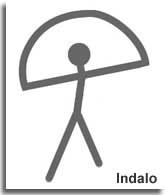
The Indalo Man talisman, a stick figure with an arch over his head, seen on jewellery, key fobs, t-shirts, and embellishing the frontage of many local businesses and homes, is recognised as the village good luck symbol as well as the adopted emblem of Almeria province.
It was also the insignia used by the Indaliano Movement of Mediterranean Art, based in Mojacar and founded by the Almerian painter Jesus de Perceval in the 1940s. Its heritage has links to the prehistoric painted cave markings of Cueva de los Letreros in the Sierra Maria natural park in the north of the province.
Cueva de los Letreros - Sierra Maria natural park ![]()
Sight seeing in Mojacar Pueblo
The best way to appreciate the village, its pretty buildings, winding walkways, sights and sounds, is naturally on foot.
I recommend using the quality map provided by the tourist information centres, it details all the places of interest and will take you on the perfect guided tour of the village.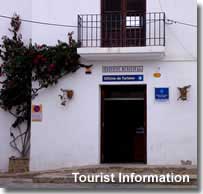
Below I have detailed my own walk through the village, using the map as my guide, starting at the fountain at the base of the village and ending at the observation point right at the top.
Tourist Information Centres in Mojacar
Mojacar Playa - the kiosk is situated by the beach across from the Parque Comercial shopping centre.
Mojacar Pueblo - the centre is located in the square by the church tower and signposted from the main Plaza Nuevo.
Access from the beach
It is a reasonably short walk from the coast to the pueblo, 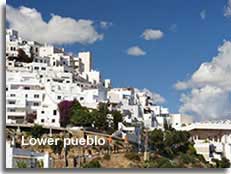 however it is all uphill, a regular bus service runs from the commercial centre where taxis are also available.
however it is all uphill, a regular bus service runs from the commercial centre where taxis are also available.
Parking in the village is limited, especially in high season, the main car park can be reached along the single entry road approximately 300m past the turning for Plaza Nueva.
Mojacar village guided tour
The lower pueblo marks the starting point of this guided tour, at this point there are numerous cafes, bars, and trinket shops, with the option to follow the road on the steep climb to the main part of the village or 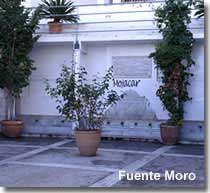 take a detour, to the right, to the village fountain and Centro de Arte, Art Centre.
take a detour, to the right, to the village fountain and Centro de Arte, Art Centre.
La Fuente Moro, Mojacars fountain, has been a vital water source to the village for centuries, in Moorish times it was the centre of the Mojaquero social life, even now residents still use the water for drinking by filling up their plastic water bottles in a weekly ritual.
An important part of Mojacars history, the significant peaceful surrender of the Moorish village to the Catholic Kings, 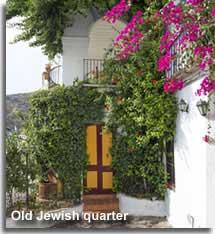 is written on a commemorative plaque situated above the twelve water spouts.
is written on a commemorative plaque situated above the twelve water spouts.
On leaving the fountain the main road continues up and around the outskirts of the pueblo offering access to the main square, Plaza Nueva, the penultimate destination of this route.
However, following the map and cutting through the village, by taking the first or second available pathway to the left, leads to the original city entrance via Plaza Flores in the old Jewish quarter.
Puerta de la Ciudad also known as Puerta de la Almedina, is the old city gateway, dating back to the 15th century, the archway proudly displays the Mojacar coat of arms and the inscription of Puerta de la Ciudad, doorway to the city, in both Spanish and Arabic.
After passing under the archway the next port of call is the main street  of Calle de Enmedio, home to the Ayuntamiento de Mojacar, the town hall building, and its pretty plaza, a gathering spot for the locals, the plaza cafe bar utilises the square as its outside seating area, daytime shade is provided by a magnificent old tree and subtle lighting creates a special evening atmosphere.
of Calle de Enmedio, home to the Ayuntamiento de Mojacar, the town hall building, and its pretty plaza, a gathering spot for the locals, the plaza cafe bar utilises the square as its outside seating area, daytime shade is provided by a magnificent old tree and subtle lighting creates a special evening atmosphere.
Across from the town hall a narrow stairway ascends to the Plaza del Parterre, now a beautifully maintained square decorated with numerous plants and flowers, 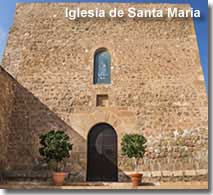 it was once the location of the old
it was once the location of the old 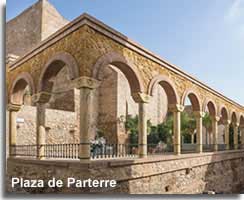 Arab cemetery and is situated by the side of the church.
Arab cemetery and is situated by the side of the church.
The church itself, Iglesia Santa Maria, holds a commanding presence, its fortress like structure serves as a reminder of times gone by.
As does the Mojaqueras statue, it stands in the square at the church entrance, a marble memorial to 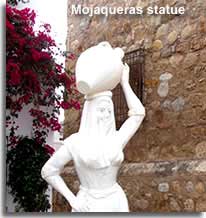 the village women of Mojacar and a representation of their typical dress and traditional role of water carrier. The female statue expertly covers her face with her shawl, held in place by her teeth, while she carries a pitcher of water on her head.
the village women of Mojacar and a representation of their typical dress and traditional role of water carrier. The female statue expertly covers her face with her shawl, held in place by her teeth, while she carries a pitcher of water on her head.
From here, a left turn affords access to Plaza Fronton and the Tourist Information Centre, turning right, along Alcalde Jacinto,  leads to Plaza Nueva, the main square of the village, which is always buzzing with sightseers and shoppers.
leads to Plaza Nueva, the main square of the village, which is always buzzing with sightseers and shoppers.
Many of the shops, bars, cafes and restaurants are situated in the cobbled streets surrounding the main square and along and around Calle de Enmedio.
Mirador de la Plaza Neuva, the platform on the edge of the plaza,  presents amazing views down to the valley below as well as a place to sit and relax, sample some local refreshments and soak up the vibrant atmosphere.
presents amazing views down to the valley below as well as a place to sit and relax, sample some local refreshments and soak up the vibrant atmosphere.
One final place of interest, signposted from Plaza Nueva, is the Mirador del Castillo, a steep climb, up yet more cobbled walkways, leads to the viewing point at the highest point of the village, from where there are magnificent views of Mojacars coastline and the Mediterranean sea.
Shopping in Mojacar old town
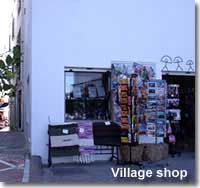 Shopping in the pueblo is all about discovering the curious little places that line the walkways and plazas.
Shopping in the pueblo is all about discovering the curious little places that line the walkways and plazas.
There is a good choice of local crafts for sale, such as rugs, ceramics, wrought iron works and leather, besides, of course, the usual touristy souvenirs and Indalo charms.
Fashion is well represented with various boutiques covering styles such as bohemian, vintage, modern and classic. With plenty of quality establishments, a selection of exclusive shops, and some distinctly individual stores, no one should walk away empty handed.
The weekly market comes to the village on Wednesdays, providing fresh locally grown produce, and on Sunday mornings the Rastro market offers a mix of all sorts from locals and traders. 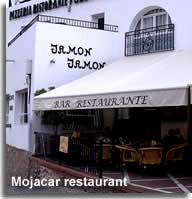
Eating out in Mojacar village
With cafe lined plazas and discreet hidden restaurants Mojacar pueblos eating establishments offer a diverse fusion of flavours in wonderful settings.
A choice of Italian, French, British and Argentinian, among other dishes, can be sampled, though Spanish cuisine is obviously the most prevalent with tapas, raciones, menu del dia and meat and fish specialities.
Daytime or evening the cafes, bars and restaurants create an ambiance to be savoured, often in locations that once 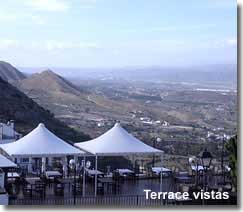 stumbled upon need to be remembered.
stumbled upon need to be remembered.
After dark
After sunset Mojacar Pueblo becomes even more captivating, its mysterious streets come alive with an aura of expectation and awaited discoveries.
Select restaurants with candlelit terraces light up the village offering romantic dinners and relaxed venues for a special experience within exceptional surroundings.
The bars and nightspots in the village are chic and low key, for music and dancing Mojacar Playa has more on offer, especially in high season.
Mojacar Playa - the beach resort
A thirty minute downhill stroll or a five minute bus ride from Mojacar village finds the beaches, hotels, urbanisations, 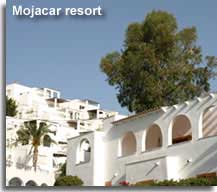 shops, bars, cafes, restaurants and nightclubs that make up Mojacar Playa, a low rise beach resort with an apparent Andalucian style.
shops, bars, cafes, restaurants and nightclubs that make up Mojacar Playa, a low rise beach resort with an apparent Andalucian style.
Deserving of and detailed in a separate page, 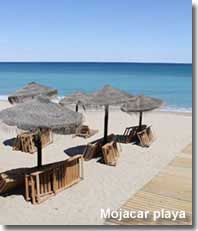
the beaches of Mojacar ![]()
are a main draw for the resort, yet it does have much more to offer.
The Parque Comercial, a popular centre with lots of shops, cafes and restaurants, denotes the access point from Mojacar Pueblo to the Mojacar Playa beach road and promenade.
Turning left towards Garrucha town offers some quality hotels and beaches, a golf resort, and a quieter holiday location, turning right, invites the livelier resort centre.
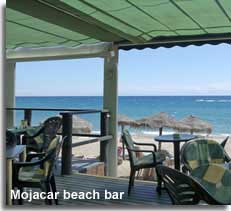
This is still a very traditional area of Spain where family values are of the utmost importance and the resort is geared up for families and children with play parks and ice cream parlors along the seafront promenade.
Relaxing entertainment venues and quality eating establishments span the length of the spacious beach areas, where the atmosphere is laid back and friendly.
That said, it has to be noted that in the high season months of July and August, this normally peaceful holiday spot comes alive, and the beaches, hotels, shops, restaurants, bars and clubs are bustling with holiday makers.
There is a reasonable size expatriate community in Mojacar, not surprisingly many have chosen to live here permanently, with a wide mix of aged groups from the retired to a good number of younger couples and families. 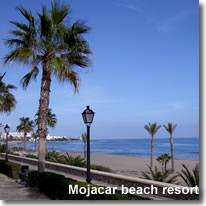
Transport - Mojacar Playa and Mojacar Pueblo
There are regular buses that run the length of Mojacar Playa along with a scheduled service from the playa to the pueblo, the timetables are detailed on the bus stops and available from the tourist information centres.
Taxis are readily available, and there is a taxi rank next to the commercial centre.
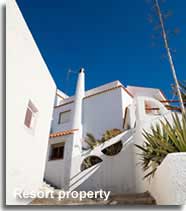
Choose Mojacar for property
Property in Mojacar
Mojacar is a prime location for property, yet it can still offer sensibly priced property particularly when in comparison with similar properties in the more well know Costas of Spain.
Whether the location is village, beach front, or in the surrounding countryside, the choice of property is diverse, apartments, villas, town houses, traditional cortijos, golf resort properties, for holiday homes or permanent residence, new build and re-sale.
Not surprisingly then that there are a good number of estate agents based in Mojacar, specialising in one, all or a combination of property for sale, property for rental and holiday let property.
Being a holiday hot spot there are naturally investment opportunities for buy to let properties, either for long term or holiday rentals.
Choose Almeria property listings for Mojacar Playa and
Fiestas of Mojacar
Santa Semana - Holy Week.
Celebrated in the week leading up to Easter, the lively festivities include the important Good Friday procession.
This religious parade follows a statue of Jesus Christ baring his cross, it ascends the cobbled streets of the pueblo to the church and is followed by the municipal band and many visitors who flock to the village to witness the moving ceremony.
Romería de San Isidro - San Isidro pilgrimage.
On a Sunday in mid May the villagers of Mojacar, in honour of San Isidro, make a pilgrimage to Sopalmo, a small hamlet in the heart of the hills between Mojacar and Carboneras.
The journey from Mojacar to Sopalmo is done in true Spanish style, a procession of flower decorated floats and trailers, accompanied by music, is followed by cars, vans and motorcycles, and much horn beeping.
Once at the destination families and friends will celebrate with a feast of food and drink.
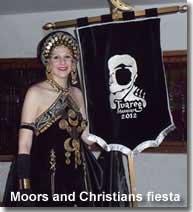
The Moors and Christians Fiesta.
This is the most important fiesta of Mojacar, where many of the villagers don their acting hats and their elaborate costumes and throw themselves into the portrayal of the heroic legend from the 15th century interactions between the long standing Arab residents and the Catholic invaders.
Celebrated early to mid June, this renowned three day fiesta is not only visited by citizens of the province but by tourists from all over Spain and Europe.
The story behind the festivities relate to the Christian Conquest of the territory involving the addition of Mojacar to the Kingdom of the new Catholic Monarchs, Ferdinand and Isobel, after centuries of Arab rule. 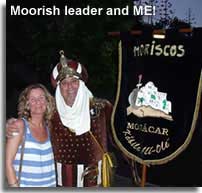
It tells the tale of how the Moorish governor of Mojacar made a stand for his people in a brave statement to his aggressors, it is said that in his declaration he was insistent that he would only pledge allegiance to the new rulers if they would allow his people to remain in their homes and to keep the land that they and their ancestors had worked and lived on for centuries gone by, thus living side by side and in peace with the new rulers.
Taking a huge risk, he is quoted as saying that before he would 'surrender like a coward' he would be prepared to 'die as a Spaniard' such were his beliefs for the rights of his people. 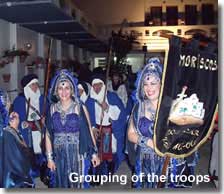
His bravery paid off and enabled a compromise to be made between the two religions, the deal was sealed and Mojacar was officially and peacefully handed over to the Christians.
Fact or folklore? It doesn't seem to matter, the retelling of the story through the fun of the fiesta has brought untold pleasure to both participants and spectators, and of course has given us all a good excuse for nightlong merrymaking.
Commencing on a Friday the evening events start around 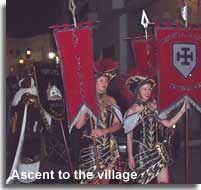 10pm at the foot of the pueblo with blunderbuss firers and the grouping of the troops at the public fountain.
10pm at the foot of the pueblo with blunderbuss firers and the grouping of the troops at the public fountain.
It was here many years ago that the Moorish leader is said to have made his courageous statement to the Christian ambassador, and the scene is reenacted in the key to the city ceremony on the gallery overlooking the fountain and above the plaque on which the historical events are written.
The troops then ascend and enter the village, presided over by their respective captains and accompanied by bands, 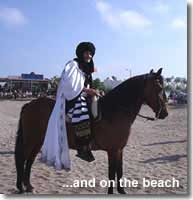 fireworks and musket fire where the fiestas continues until the early hours.
fireworks and musket fire where the fiestas continues until the early hours.
Saturday sees a confrontation between the Moorish and Christian troops down on Mojacar Playa beach.
An exhibition of horsemanship and a belly dancing show precedes a medieval tournament between the Moorish and Christian knights, 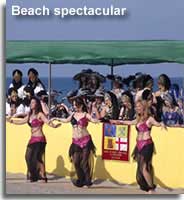 after which the troops march to the commercial centre joined by entertainers and spectators.
after which the troops march to the commercial centre joined by entertainers and spectators.
The beach events start late afternoon, around 6pm, and are held at Playa Descargador, on Mojacar Playa.
Later, back in the pueblo, the opening of the troops encampments, at around 10pm, marks the start of the evenings entertainment and the party continues until dawn!
Sunday afternoon presents a concentration of fusiliers along the beach, with lots of blunderbuss shots.
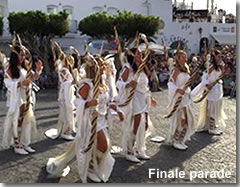
The grand finale of the whole event is held on Sunday evening, in the form of a colourful procession through the village streets.
Proud participants, dressed in the most spectacular costumes, and accompanied by numerous musical bands, make their parade, via Plaza Nueva and down to the fountain.
A once in a lifetime experience not to be missed.
The start time is approximately 6.30pm.
The Medieval Market
Adding to the entertainment and village atmosphere, is the day and time night medieval market, with stalls offering traditional trinkets, craft work and jewellery, samples of customary cuisine, and a mystical ambiance to the whole affair.
I love this market, and have spent many happy times browsing the exquisite silver jewellery, and I once bought a custom made belt from a stall offering choices in different leathers, widths, colours, and buckles, which I have to say I still own and wear to this day.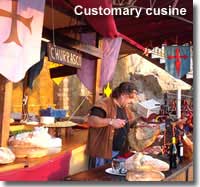
It is worth noting that entry to the village by vehicle tends to be prohibited 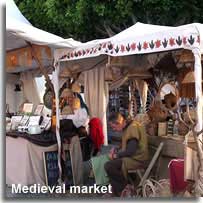 from around 10pm each evening.
from around 10pm each evening.
There are however plenty of buses, which run from the beach up to the pueblo, and taxis are readily available.
Fiesta in honour of Saint Agustín.
A weekend event at the end of August in honour of Mojacars patron saint.
Festivities include the floral offerings and procession of the Mojaqueras, where women, dressed in traditional costume, carry pitchers of water and flowers from the fountain to the church.
Another fiesta tradition, the Corridas de Cintas, involves the young men of the village generally showing off their horse riding skills as they ride under a rope aiming to reach up and remove one of the coloured tapes which have been loosely attached by the single females of the village.
I have actually seen this ritual executed on motorbikes instead of horses, quite a noisy but a fun spectacle, there is also a childrens version performed on bicycles.
Fiesta in honour of Nuestra Señora del Rosario.
A celebration, in early October, of the female patrona of Mojacar, the Virgen del Rosario. The fiesta activities again include the Corridas de Cintas.
Fiestas de Navidad - Christmas in Mojacar.
The main celebration in Spain for the festive season is Epiphany, it is rejoiced in Mojacar with the Three Kings parade on the 5th of January.
Christmas sees recitals of popular carols and activities for children and the New Year offers a celebration in the shadow of the church tower, where wishes for the coming year are passed to friends and family.
External link
Provided to help visitors make the most of the area. The link will open in a separate page.
Itineraries for the fiestas can vary from year to year, as can the exact dates. The Mojacar Town Hall website, detailed in both Spanish and English, provides a comprehensive guide, with photos, for each of Mojacars fiestas, including a programme of events for the main festivals.
Outdoor recreation
With year round sunshine and mild winter temperatures, the natural landscapes around the Mojacar area of Almeria provide an ideal environment to enjoy outdoor recreational activities all year long. 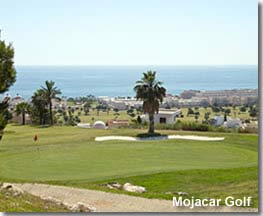
Golf is available at the Marina golfing resort.
Marina Golf club - Mojacar Playa ![]()
Lawn Bowling opportunities are on hand at the club in the Marina de la Torre area, towards the Garrucha end of Mojacar Playa.
Mojacars uncrowded coastline, part of the Levante coastline of Almeria, is a great place to practise a variety of water sports, such as sailing, snorkelling, windsurfing, and fishing, with the scuba diving sites of Villaricos, Carboneras and Cabo de Gata all within easy reach. 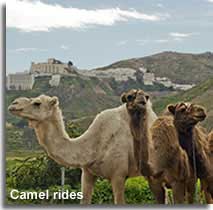
Water sports - including the Levante and the Cabo de Gata coastlines ![]()
Horseback riding, cycling, hiking, and 4x4 trips are all covered and there are even camel rides from Marina de la Torre.
Horse riding in Almeria - including the local centres in Mojacar and the Sierra Cabrera ![]()
The Municipal Sport Centre, within the village itself, has an indoor pool and fitness room.
Walking trails - Mojacar
For walking and hiking Mojacar, and its surrounding countryside, offers many possibilities.
La Mena - Macenas
Length : 9.5 km
Estimated completion time : 2:20 Hours
Difficulty level : M.I.D.E 1-1-1-2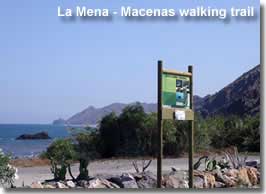 This circular signposted trail starts at the end of the beach promenade, at the far end of Mojacar where the coastal road turns inland and heads towards Carboneras.
This circular signposted trail starts at the end of the beach promenade, at the far end of Mojacar where the coastal road turns inland and heads towards Carboneras.
The trail takes a route along the coastal cliffs, one which was once used, in the 19th century, by miners, shippers, and carriers, during a five year period of intense iron ore mining in the Macenas, it also leads the way to the secret beaches of Mojacar. The beginning of the trail ascends through a narrow and rocky pathway in an area of great biological diversity and scenic beauty, from the height of the path the seabed can be seen through the transparency of the waters and sea birds that use nearby islands, such as gulls and cormorants, can be spotted.
Further along the walkway, 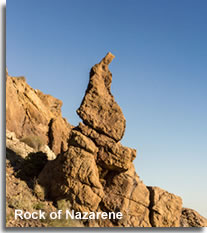 above a singular crag known locally as the Stone of the Nazarene, the remains of mining activity can be appreciated in the form of old landings and hoppers, the entrances to the mines now provide shelter for several species of bats and predatory birds such as kestrels and hawks.
above a singular crag known locally as the Stone of the Nazarene, the remains of mining activity can be appreciated in the form of old landings and hoppers, the entrances to the mines now provide shelter for several species of bats and predatory birds such as kestrels and hawks.
The trail continues to the Castillo de Macenas which overlooks Macenas beach, this 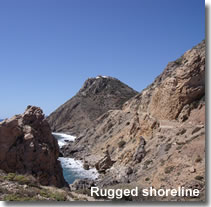 military construction was built in the 18th century as part of a defense system to protect the area from invaders. From here the Perulico tower, an important look out point constructed under the rule of the Nasrid dynasty, can be identified further along the coastline.
military construction was built in the 18th century as part of a defense system to protect the area from invaders. From here the Perulico tower, an important look out point constructed under the rule of the Nasrid dynasty, can be identified further along the coastline.
The Perulico tower is situated in a position of intense natural beauty and offers the most amazing views of the rugged shores. At this point the route returns on itself back to the starting point, however it is possible, and highly recommended, to continue along the coastal pathway on to the hidden beach of El Sombrerico.
The hidden beaches of Mojacar including El Sombrerico ![]()
Walking trail classifications and markers are explained in walking in Almeria ![]()
More walking trails in the Levante area
The walking trails in and around the area have already been very well documented by the Walking Group of Mojacar, they include old railway routes, coastal pathways, ramblas, forests, valleys and fruit groves, offering historical and cultural interests as well as beautiful landscapes, with both simple and challenging routes.
External link
Provided to help visitors make the most of the area. The link will open in a separate page.
Mojacar Walking Group website, in English. I do recommend taking a look at this website, each walk is very well documented and there are some fantastic photos.







